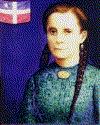Yuiza:
The first and only female Cacica of Boriken

Born in the late 1400's, Yuiza was born the daughter of the Taino people of Borikén (current day Puerto Rico). Throughout her life, though much remains difficult to uncover due to the Spaniard's attempt to erase Taino culture from grasp, Yuiza is said to have been the first and sole female Cacique of her tribe and on the island. As Cacica, she was a revered and beloved leader who helped fight against Spanish infiltration and pollution. Being a poet, leader and personified display of women's strength within the Taino populace and community, she is said to have folklores made of her in admiration, depicting her as the daughter of the sun god, Yúcahu and a gift from the god of life, Atabei.
Although she was the Cacica for some time and worked against Spanish occupation, she later fell in love with Spaniard Pedro Marías, who she married against her tribe's wishes. In 1515, around 22 years after the first landing of the Conquistadores, Yuiza was ambushed and killed by her tribemates because of her marriage to Marias. Today, in Puerto Rico, or the island of Boriken, her story and life lives on through oral and documented history. The most obvious reference to her on the island is the name of the town Loíza, which was named after her and tells her story and the story of the natives that once solely inhabited the island.
Quick note: Please keep in mind that there are many adaptations of her name, such as Yuiza, Yuisa, Loíza, and Luisa. However, based on the Taino words and language preserved to this day, many use the spelling 'Yuiza' because of the ties to both the folklores and language consistency.
Mariana Bracetti:
Revolutionary and Maker of the first Puerto Rican Flag

Born on July 26, 1825 to Venezuelan father Francisco Bracetti and Puerto Rican mother Antonia Cuevas, Mariana Bracetti Cuevas was the youngest of ten siblings. Though minimally educated throughout her life due to societal restraints on education, as well as her family's meager resources as a small landowner family, she lived a life of inquisition and innovation. Raised closely to her mother, who she named all three of her daughters after, and being inspired by her experiences, she lived her life a fighter of oppression and discrimination. After being widowed by her husband José Adolfo Pesante Paz in 1856 (married Jul. 26, 1850) , she was one of many who lived through the troubling time of the Cholera Epidemic in Puerto Rico. As over 30,000 people died across the island, including 5,000 slaves, she and many of her peers decided it was time for change; the main source of the disease and many of the oppression people experienced being from the Spanish leaders and controllers of the island.
One of the most pinnacle and historical moments she contributed to was the Grito de Lares rebellion of 1868. Appointed one of the few leaders of the Revolutionary Committee of Puerto Rico, el Comité Revolucionario de Puerto Rico, and the only female one at that, she and other leaders like Ramon Emeterio Betances and Manuel Rojas began organizing a protest to bring Puerto Rico's issues to the front of people's minds. Going from distributing proclamas, or pamphlets, and creating minimal change with non-direct nonviolent action, they decided to switch their tactics up a bit. Originally planned six days later, the Grito de Lares, or Cries for Lares, rebellion began on September 23, 1868. During that one day, the 400-500 revolutionaries filled the roads of the town of Lares. Raiding stores of local elites, holding some Spanish leaders captive and chanting their demand to let Puerto Rico be free from Spanish rule, the revolutionaries and protesters marched to the heart of Lares and as the day ended, they victoriously declared Puerto Rico's independence from Spain. Within the late hours of the day, they finalized Puerto Rico's first Declaration of Independence, declared the first President as Francisco Ramirez and made the first flag of Puerto Rico, which was sewn by Mariana Bracetti, as well as few other women. Unfortunately, the Spaniard forces had gained more intel on the revolutionaries and stopped them as they attempted to enter the next town the day after, arresting around 400 of the protesters; only one woman was arrested alongside the majority male group: Mariana Bracetti.
Although there were many roadblocks the movement faced, Mariana Bracetti played a vital role in the road towards Puerto Rican independence. After being pardoned by the later appointed Spanish Governor of the island, she continued to convene with her comrades and find ways to spread empowerment and the song of Puerto Rican independence to as many people on the island until her death in 1903. From leading and working as a member of el Comité Revolucionario de Puerto Rico, and participating in the historical moments in Boricua history she did, Mariana Bracetti is one of the many Puerto Rican women who have well earned their taste of spotlight. She was even called 'Brazo de Oro' or the Golden-Arm, signifying her unwavering determination and power against anyone and anything in her way towards the goals she believed in. Even over a century later, Puerto Rican women are inspired by the groundbreaking and unequivocal work she has left to show Puerto Rican strength in the face of oppression.

